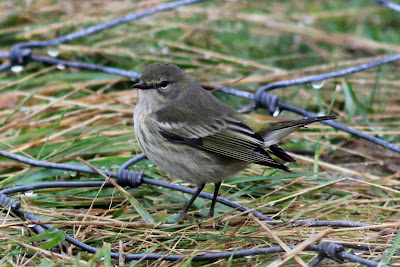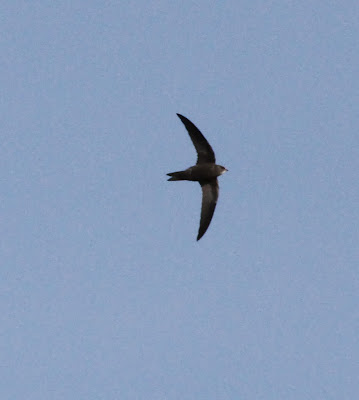Waking up in Yorkshire, I was still uncertain whether to head South to the Hermit Thrush or North for the Mourning Dove. Early negative news from Cornwall confirmed I should be heading North. The Hermit Thrush news finally went positive by the time I was passing Scotch Corner, but I was going to struggle to get back to Cornwall by that time, especially with foul Cornish weather predicted for later that day. It was a pleasant drive to Fort William as the next boat to Rum wasn't till the following morning.
After a night in Fort William, it was an hour's drive to Mallaig for the ferry. The ferry was scheduled for a stop at Rum, then Canna & back to Rum again 2.5 hours later, before finally returning to Mallaig. However, with the weather forecast of Force 6+ winds, the sailing was disrupted and was only making a single visit to Rum, before returning to Mallaig. After quickly throwing a few extra bits in the rucksack I was prepared for a stay on the island. There was only 1 birder, Ewan Urqhart,(black audi birding blog) also waiting for the ferry & he was booked in the island's hostel. With only 4 other locals on the boat, then felt I was safe with turning up unannounced for the hostel. Not surprisingly, we had the hostel to ourselves.
Mallaig: A helpful local pointed out the way to go
I was glad to get ashore on Rum after a rough crossing. The island of Rum is owned by Scottish Natural Heritage and is mainly a National Nature Reserve. However, in 2009/2010, the Kinloch village was transferred to the Isle of Rum Community Trust which houses the 44 residents on the island.
Rum: A mountainous island & home to over 60,000 Manx Shearwaters
Kinloch Village, Rum: Taken just after one of many wet squalls we encountered. Rock Cottage is the most right hand white cottage
Kinloch Castle, Rum: This Edwardian shooting lodge featured in the 2003 Restoration series with Griff Rhys Jones, but failed to win the cash needed to restore it
Jetty, Rum
Kinloch Hostel, Rum: This was a warm & comfortable hostel with self catering facilities & friendly staff
Mourning Dove: Note, the pale sides to the breast
Enough about the cultural side for now, once the bags were dropped at the hostel it was quickly onto the Mourning Dove location at Rock Cottage.
It's always good to know where to go
The Mourning Dove wasn't on view when we arrived, but as there were only 2 of us we were allowed to stand in the garden. After an hour or so, it dropped in briefly onto the grass, before quickly flying up into the conifers again. Fortunately, it returned after 30 minutes or so, & gave some nice prolonged views while it was feeding under the conifers with the Chaffinches.
Mourning Dove: Smaller than a Collared Dove with a longer tail & obvious white flashes to the sides of the tail
Brambling: Showing its orangey breast (second from right)
Brambling: Showing its distinctive white rump
The Mourning Dove was a shy, wary bird and was generally only being seen first thing in the morning and late afternoon close to dusk, so we were lucky to get good views on the ground in early afternoon. My second tick in 3 days which took me to 515 for the British & Irish List (BOU/IRBC birds). Every now & then it was spooked when the Chaffinch flock were spooked by the local Sparrowhawk. Easier to see were the resident Hooded Crows.
After the Mourning Dove disappeared, we decided to explore a bit more around Kinloch bay for the rest of the afternoon.
Greylag Goose: More approachable that the Mourning Dove, but they still walked away slowly
The hub of Kinloch village: At last the weather has improved







































